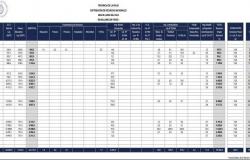
It was the 90’s and stores selling products imported from China with ornaments and decoration for the home and low-cost items began to swarm the shopping centers on streets and avenues.
They were also times when free restaurants offered dinners for $5 to $10 per person, depending on the quality and quantity of dishes offered in establishments linked to Asian gastronomy.
That decade ended with a parody of the television show they hosted Fabio Alberti and Diego Capusottoscripted by Pedro Saborido and Nestor Montalbano. Convertibility began to creak and the program Todo x $2 began to be broadcast in 1999, before the turn of the century.
In the ’90s the economy was governed by the convertibility regime, where one peso was equivalent to one US dollar: a fixed parity of one to one was maintained since April 1991.
In the ’90s the economy was governed by the convertibility regime, where one peso was equivalent to one US dollar.
The list of typical products in a bazaar was worth $2, that is, 2 dollars. This type of format lasted a long time, but already validating the problems of chronic inflation in Argentina with price increases that in just over a quarter of a century exceeded 100,000%, those $2 are today equivalent to a value of between $3,000, some products are slightly below and another still above.
The equivalent price change in dollars was substantially more attenuated at the official exchange rate, between 20% and 130 percent. For example, a toilet paper roll holder increased 75.3 percent.
It is interesting to observe how $2 from the ’90s, equivalent to USD 2, when adjusted for inflation today rises to just over 4.4 dollars.
Products that had a value of USD 2 in the nineties today range between 2.40 and 3.51 dollars.
If the update exercise is done at the free dollar rate, the situation changes for some products, for example, a ceramic mug costs 17.4% less today compared to the 90s, but others cost between 10% and 30% more. high.
Two dollars from the early ’90s are currently equivalent to $2,460, that is, $1,230 per unit, which is an average reference price for many items.
The “Everything x $2” became “Everything x $3,000.” Finding businesses that offer items at a single price in Argentina is a “déjà vu” that begins to dream of lower inflation, currency competition and an eventual future dollarization.
This type of establishment had price transparency as its model. Something that with the accumulated inflation since the beginning of the ’90s until now of 143.868% sounds more like a tango with melancholy for the pocketbook than a possible reality. The uncertainty regarding the prices of all goods and services displayed at points of sale still remains a problem in the management process.
In the last 12 years there was an attempt to return to fixed prices in the regulated prices of public services, but it failed again due to the accumulation of fiscal and monetary imbalances, and today the consequences of those policies are being paid, both by the correction of deviations and loss of quality of services.
In the last 12 years there was an attempt to return to fixed prices in the regulated prices of public services, but it again failed due to the accumulation of fiscal and monetary imbalances.
If you take a basket of public services composed of electricity, gas, water and transportation, you notice that currently you only pay, on average, 37% of their total cost.
President Javier Milei He adopted the musical theme “Panic Show” by the rock band “La Renga” for his political campaign, modifying the lyrics: “Please don’t run away from me. I am the king of a lost world. I am the king and I will destroy you. All accomplices are of my appetite.” He changes that last section to “the whole caste is my appetite.”
In the ’90s “La Renga” was invited to “Todo x $ 2” to play her song “2+2=3” in which she says “If 2+2 gave 3 it’s safe it would calm my stress a little, I would have one point less inflation and in the Everything x $ 2 a peso in my favor.”
The entire caste increased public spending and monetary issuance without support for more than 20 years. Hence, today we do not have the “Everything x $2” in our favor, but rather a surcharge of 2,998 pesos, an inflation – for that matter – of 149,900 percent.
The author is an economic analyst





